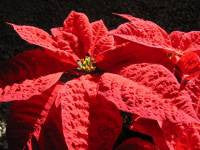Poinsettia time November 22 2014, 0 Comments

In the Northern Hemisphere, poinsettias are now available in plant nurseries. These plants have become a part of winter holiday traditions, so it is likely that children will see them. When poinsettias appear in classrooms, you have an opportunity to introduce children to the euphorbia family and its unusual flowers.
Don’t worry about these attractive plants being poisonous. That myth has been debunked. The sap of this plant, like other members of the euphorbia family, is irritating to skin and eyes, but the plant is no great hazard in the classroom. They are no more than a mild irritant to cats and dogs. People that have an allergy to natural latex rubber could have an allergic reaction to the sap, as natural rubber comes from another member of the euphorbia family, the rubber tree, Hevea brasiliensis.
I have written a booklet for children that shows how poinsettias are grown and gives the botanical details of their bracts and flowers. It is available as a print-it-yourself file on the Big Picture Science website. I took the photos a few years ago at a small greenhouse near Conifer, Colorado. In order to trigger the plants to form flowers, they must have a dark period at night. Even a little light exposure will stop the production of buds. The greenhouse I visited was well away from the pollution of city lights.
The length of the darkness increases as days become shorter in the fall, and that is what triggers poinsettias to flower. In their native climate in Mexico and Central America, the length of darkness is only about 13 hours maximum, so flowering doesn’t require a long period of darkness. The darkness needs to be complete, however.
The brightly colored bracts are modified leaves. The flowers are in the yellow, cup-like structures in the center of the bracts. They have no petals, and children will be able to see the flowers’ details more clearly with a magnifying glass. My booklet, The Story of Poinsettias at TaTonka Farms, will help you figure out the puzzle of the flowers' structure.
